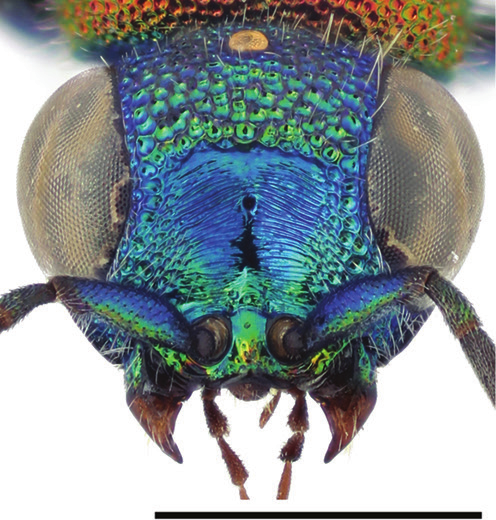Chrysis leachii
- Innhold
- Diagnosis
- Distribution
- Biology
Diagnosis
Figure 150
Head, frontal view (arrow indicating frontal carina): Chrysis leachii ♀. Scale 1 mm.
Length 3–6 mm.
The species is similar to C. succincta in having an edentate posterior margin of T3 (as in Fig. 77), but the margin is medially more sharply pointed, especially in the female. The center of the scapal basin is finely cross-ridged (Fig. 150) or it is dull and densely microsculptured. The colouration resembles that of C. succincta, but the mesoscutellum is red (not blue) and the tergites are often posteriorly narrowly green or blue. The males are usually more greenish than females.
Distribution
Denmark. Very rare. Only one male and one female are known, recorded from the island of Funen (Helnæs, 19.VIII.1918, leg. L. Jørgensen).
West Palearctic: Europe, northern Africa, Asia Minor (Linsenmaier 1997, 1999).
Be aware that the records present in the GBIF map may be misleading for some countries due to unrevised data sets or missing information.
GBIF Taxon: Chrysis leachii Shuckard, 1836Biology
Habitat: steep sand and loess slopes and stone walls (Ressl 1966, Kusdas 1956, Gerth et al. 2010). Adults occasionally visit flowers of Apiaceae, Caryophyllaceae and Euphorbiaceae (Graffe 1895, Linsenmaier 1997, Rosa 2004).
Flight period: June to August.
Host: probably Diodontus minutus (Fabricius) and/or Miscophus bicolor Jurine (Crabronidae) (Trautmann and Trautmann 1919, Linsenmaier 1959, Heinrich 1964, Gerth et al. 2010). We consider records of other host species (e.g. Tachysphex nitidus (Spinola)) as uncertain due to lack of supporting information.
